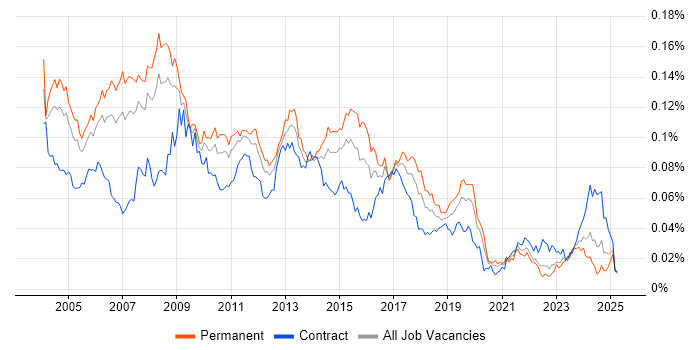Database Analyst
UK
The median Database Analyst salary in the UK is £60,000 per year, according to job vacancies posted during the 6 months leading to 19 May 2025.
The table below provides salary benchmarking and summary statistics, comparing them to the same period in the previous two years.
| 6 months to 19 May 2025 |
Same period 2024 | Same period 2023 | |
|---|---|---|---|
| Rank | 702 | 852 | 967 |
| Rank change year-on-year | +150 | +115 | +249 |
| Permanent jobs requiring a Database Analyst | 10 | 38 | 10 |
| As % of all permanent jobs advertised in the UK | 0.018% | 0.038% | 0.010% |
| As % of the Job Titles category | 0.020% | 0.040% | 0.011% |
| Number of salaries quoted | 5 | 29 | 10 |
| 10th Percentile | - | £33,700 | £23,775 |
| 25th Percentile | £37,000 | £35,000 | £31,062 |
| Median annual salary (50th Percentile) | £60,000 | £38,000 | £38,750 |
| Median % change year-on-year | +57.89% | -1.94% | -8.82% |
| 75th Percentile | - | £50,000 | £45,750 |
| 90th Percentile | - | - | £63,375 |
| UK excluding London median annual salary | £38,000 | £36,476 | £35,144 |
| % change year-on-year | +4.18% | +3.79% | -17.31% |
All Permanent IT Job Vacancies
UK
For comparison with the information above, the following table provides summary statistics for all permanent IT job vacancies. Most job vacancies include a discernible job title that can be normalized. As such, the figures in the second row provide an indication of the number of permanent jobs in our overall sample.
| Permanent vacancies in the UK with a recognized job title | 50,683 | 94,601 | 90,752 |
| % of permanent jobs with a recognized job title | 90.72% | 94.69% | 91.52% |
| Number of salaries quoted | 27,196 | 67,610 | 57,343 |
| 10th Percentile | £29,500 | £28,500 | £32,500 |
| 25th Percentile | £41,250 | £38,500 | £45,000 |
| Median annual salary (50th Percentile) | £55,320 | £52,500 | £60,000 |
| Median % change year-on-year | +5.37% | -12.50% | - |
| 75th Percentile | £73,750 | £71,000 | £80,000 |
| 90th Percentile | £95,000 | £90,000 | £100,000 |
| UK excluding London median annual salary | £51,564 | £50,000 | £53,000 |
| % change year-on-year | +3.13% | -5.66% | +6.00% |
Database Analyst
Job Vacancy Trend
Job postings that featured Database Analyst in the job title as a proportion of all IT jobs advertised.

Database Analyst
Salary Trend
3-month moving average salary quoted in jobs citing Database Analyst.
Database Analyst
Salary Histogram
Salary distribution for jobs citing Database Analyst over the 6 months to 19 May 2025.
Database Analyst
Top 5 Job Locations
The table below looks at the demand and provides a guide to the median salaries quoted in IT jobs citing Database Analyst within the UK over the 6 months to 19 May 2025. The 'Rank Change' column provides an indication of the change in demand within each location based on the same 6 month period last year.
| Location | Rank Change on Same Period Last Year |
Matching Permanent IT Job Ads |
Median Salary Past 6 Months |
Median Salary % Change on Same Period Last Year |
Live Jobs |
|---|---|---|---|---|---|
| England | +129 | 7 | £60,000 | +26.32% | 3 |
| London | +105 | 6 | £60,000 | +20.00% | 1 |
| UK excluding London | +169 | 3 | £38,000 | +4.18% | 2 |
| Scotland | - | 2 | £38,000 | - | |
| East of England | +39 | 1 | - | - |
Database Analyst Skill Set
Top 30 Co-occurring Skills and Capabilities
For the 6 months to 19 May 2025, Database Analyst job roles required the following skills and capabilities in order of popularity. The figures indicate the absolute number co-occurrences and as a proportion of all permanent job ads featuring Database Analyst in the job title.
|
|
Database Analyst Skill Set
Co-occurring Skills and Capabilities by Category
The follow tables expand on the table above by listing co-occurrences grouped by category. The same employment type, locality and period is covered with up to 20 co-occurrences shown in each of the following categories:
